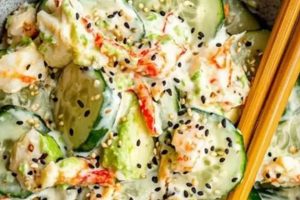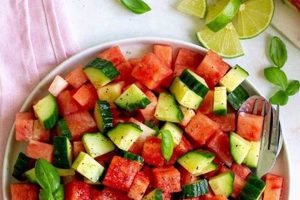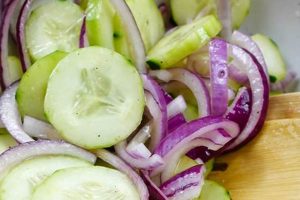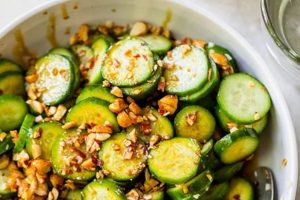A guide to preparing a dish of sliced cucumbers marinated in a vinegar-based dressing typically involves a list of ingredients, including cucumbers, vinegar, and often sugar, salt, and various herbs or spices, along with step-by-step instructions for combining and preparing them. A simple example might include thinly sliced cucumbers tossed with rice vinegar, sugar, salt, and a sprinkle of sesame seeds.
This type of salad offers a refreshing, light, and often tangy accompaniment to heavier meals. The vinegar’s acidity not only provides a distinct flavor but also acts as a natural preservative, extending the dish’s shelf life. Historically, similar preparations have been utilized across various cultures for their preservation qualities and as a way to add a bright element to meals, particularly in warmer climates. The variations are numerous, incorporating different types of vinegar, sweeteners, and aromatics, showcasing its adaptability and versatility.
This exploration will delve into various aspects of creating this culinary delight, from selecting the optimal cucumber varieties and vinegar types to exploring regional variations and innovative flavor combinations. Discussions on techniques for achieving the perfect balance of sweet, sour, and salty, as well as tips for presentation and serving suggestions, will further enhance understanding and appreciation of this simple yet versatile dish.
Tips for Cucumber Vinegar Salads
Achieving optimal flavor and texture requires attention to detail throughout the preparation process. The following tips offer guidance for creating a superior cucumber vinegar salad.
Tip 1: Salt the cucumbers and allow them to drain. This crucial step draws out excess moisture, preventing a watery salad and allowing the cucumbers to better absorb the dressing’s flavors.
Tip 2: Choose the right vinegar. Rice vinegar offers a mild, slightly sweet profile, while apple cider vinegar provides a tangier taste. White vinegar provides the sharpest flavor. Experimentation is encouraged.
Tip 3: Balance sweetness and acidity. A touch of sugar or honey tempers the vinegar’s sharpness, creating a harmonious blend. Adjust the ratio to preference.
Tip 4: Thinly slice the cucumbers. Consistent, thin slices ensure even marination and a pleasant texture. A mandoline slicer provides optimal results.
Tip 5: Add aromatics for depth. Fresh dill, mint, or cilantro enhance the salad’s complexity. Consider adding thinly sliced red onion or a pinch of red pepper flakes for a touch of heat.
Tip 6: Chill before serving. Chilling allows the flavors to meld and intensifies the refreshing qualities of the salad. Aim for at least 30 minutes of refrigeration.
Tip 7: Don’t over-marinate. While chilling is beneficial, prolonged marination can make the cucumbers overly soft. Optimal marination time typically ranges from 30 minutes to two hours.
By following these guidelines, one can consistently produce a cucumber vinegar salad that balances crispness, tanginess, and aromatic complexity. The resulting dish serves as a delightful complement to various cuisines.
From basic principles to advanced techniques, the preceding information provides a solid foundation for mastering this culinary staple. The subsequent sections will delve further into specific variations and serving suggestions.
1. Ingredients
The quality and combination of ingredients directly impact the final flavor profile and textural experience of a cucumber vinegar salad. Careful selection and preparation of each component are essential for achieving desired results. Understanding the role of each ingredient contributes to a more nuanced appreciation of this seemingly simple dish.
- Cucumbers
The primary ingredient, cucumbers provide the base for the salad. Different varieties offer subtle flavor variations. English cucumbers, known for their thin skin and minimal seeds, are a popular choice. Kirby cucumbers, smaller and firmer, provide a satisfying crunch. Regardless of the variety, freshness and proper handling are crucial for optimal texture and taste.
- Vinegar
Vinegar provides the characteristic tanginess. Rice vinegar, with its mild and slightly sweet flavor, is commonly used. Apple cider vinegar offers a more pronounced tartness, while white vinegar delivers the sharpest acidity. The choice of vinegar significantly influences the overall flavor profile.
- Sweetener
A sweetener balances the vinegar’s acidity. Granulated sugar is frequently used, but alternatives like honey, agave nectar, or maple syrup can add unique flavor nuances. The amount of sweetener used depends on the desired level of sweetness and the type of vinegar chosen.
- Aromatics and Seasonings
Aromatics and seasonings add depth and complexity. Fresh herbs like dill, mint, or cilantro provide bright, herbaceous notes. Spices such as black pepper, red pepper flakes, or sesame seeds contribute subtle heat or nutty undertones. Salt enhances the flavors and draws moisture from the cucumbers. The judicious use of these elements elevates the salad beyond its basic components.
The interplay of these ingredients determines the final character of the cucumber vinegar salad. A delicate balance of flavors and textures, achieved through careful ingredient selection and preparation, transforms simple components into a refreshing and flavorful dish. The possibilities are vast, allowing for endless customization and exploration of flavor profiles.
2. Proportions
Proportions play a crucial role in a cucumber vinegar salad, dictating the balance between key flavor components: acidity, sweetness, and salinity. The ratio of vinegar to sweetener determines the overall tanginess of the dressing. Too much vinegar can result in an overly sharp flavor, while too little can lead to a bland, underwhelming salad. Similarly, the amount of sweetener needs careful consideration. An insufficient quantity may not adequately balance the vinegar’s acidity, while an excess can create an overly sweet dish. Salt, while used in smaller quantities, is essential for enhancing the other flavors and drawing out excess moisture from the cucumbers. A proper balance of these three elements is crucial for a harmonious and palatable result. For example, a standard ratio might involve one part vinegar to one-half part sugar, with a pinch of salt. However, individual preferences and the specific type of vinegar used can necessitate adjustments to these proportions.
Understanding the interplay of these ingredients allows for adjustments based on desired outcomes. A more pronounced vinegar flavor can be achieved by slightly increasing the vinegar-to-sugar ratio. Conversely, a milder flavor profile can be attained by reducing the amount of vinegar or increasing the sweetener. The type of vinegar also influences the required proportions. For instance, a milder rice vinegar may require a higher ratio compared to a sharper white vinegar. Experimentation and careful tasting are encouraged to achieve the desired balance. A recipe intended for canning or preserving might also require adjustments to vinegar proportions for adequate preservation. These practical adjustments demonstrate the integral role of proportions in achieving a successful cucumber vinegar salad.
Mastering the art of proportion in this simple salad allows for a personalized culinary experience. Achieving the desired balance of flavors transforms a basic combination of ingredients into a refreshing and flavorful dish. The ability to adjust proportions based on individual preferences and specific ingredient characteristics ensures a consistently satisfying result. This understanding highlights the importance of precision and the subtle nuances that elevate a seemingly straightforward recipe.
3. Preparation Method
Preparation methods significantly influence the final quality and flavor profile of a cucumber vinegar salad. The way cucumbers are handled, from slicing to salting and draining, directly impacts texture and the ability to absorb the dressing. Thin, even slices ensure uniform marination and a pleasant mouthfeel. Salting and draining excess moisture prevents a watery salad and concentrates the cucumber flavor, allowing the dressing to penetrate more effectively. For instance, neglecting to salt and drain the cucumbers can result in a diluted dressing and a less vibrant final product. Conversely, over-salting can render the cucumbers excessively salty and limp. The choice of slicing technique, whether using a mandoline, a sharp knife, or a food processor, affects the surface area exposed to the dressing, influencing both flavor absorption and visual appeal.
The order in which ingredients are combined also plays a role. Dissolving the sugar and salt in the vinegar before adding the cucumbers ensures even distribution of flavors. Adding aromatics like dill or onion at different stages can alter their impact on the final dish. Incorporating them earlier allows their flavors to infuse the dressing more thoroughly, while adding them later preserves their fresh, vibrant notes. Consider the effect of adding minced garlic to the vinegar mixture versus sprinkling it over the finished salad. The former method results in a mellower garlic flavor, while the latter provides a more pungent bite. These nuanced differences highlight the importance of understanding the impact of preparation techniques.
Mastering the preparation method is essential for achieving a well-balanced and flavorful cucumber vinegar salad. Careful attention to detail, from the slicing technique to the order of ingredient incorporation, ensures optimal flavor development and textural appeal. This understanding empowers one to tailor the preparation process to achieve specific desired outcomes, be it a crispier texture, a more pronounced vinegar tang, or a subtler infusion of aromatics. The seemingly simple act of preparing a cucumber vinegar salad becomes an exercise in precision and culinary finesse, demonstrating the significant impact of technique on the final result.
4. Flavor Balancing
Flavor balancing is paramount in a successful cucumber vinegar salad recipe. The dish relies on the harmonious interplay of three primary tastes: sour (from the vinegar), sweet (from sugar or other sweeteners), and salty. The precise balance of these elements determines the overall palatability and complexity of the salad. An imbalance can result in a dish that is overly sharp, excessively sweet, or bland. The objective is to create a nuanced flavor profile where no single element dominates, but rather contributes to a unified, refreshing whole. For instance, a salad made with only vinegar and cucumbers would be overwhelmingly sour. The addition of sugar tempers the sharpness, while a pinch of salt enhances both the sweet and sour notes, creating a more complex and enjoyable flavor experience. Another example lies in the choice of vinegar. A strong white vinegar requires a greater proportion of sweetener to achieve balance compared to a milder rice vinegar. Understanding these nuances allows for adjustments tailored to specific ingredient choices and personal preferences.
The principle of flavor balancing extends beyond the core triad of sour, sweet, and salty. Aromatic additions, such as fresh dill, mint, or red onion, introduce further complexity. These elements, while not strictly impacting the sour-sweet-salty balance, play a crucial role in shaping the overall flavor profile. A judicious use of aromatics can elevate the salad from simple refreshment to a more sophisticated culinary experience. The choice of aromatics should complement the existing flavors. For example, dill pairs well with the cool, crisp nature of cucumbers and the tang of vinegar, while mint adds a refreshing herbaceous note. The quantity of these additions also requires careful consideration. Too much dill could overpower the delicate cucumber flavor, while insufficient amounts might not provide the desired aromatic lift. Therefore, achieving true flavor balance involves considering the interplay of all ingredients, both primary and secondary.
Mastery of flavor balancing in a cucumber vinegar salad demonstrates an understanding of fundamental culinary principles. It allows for adaptability and creativity within the basic framework of the recipe. By understanding the interplay of sour, sweet, salty, and aromatic components, one can create a salad tailored to specific tastes and preferences. This approach elevates the dish beyond a simple combination of ingredients, transforming it into a nuanced and refreshing culinary creation. Challenges such as regional variations in ingredient availability or personal dietary restrictions can be addressed through careful adjustments to the core flavor balance. Ultimately, a well-balanced cucumber vinegar salad exemplifies the power of thoughtful ingredient combination and the transformative effect of culinary expertise.
5. Serving Suggestions
Serving suggestions enhance the enjoyment of cucumber vinegar salad by considering its role within a larger meal or as a standalone dish. Thoughtful presentation and complementary pairings elevate the sensory experience, transforming a simple salad into a more sophisticated culinary element. Understanding these aspects allows for a more versatile and nuanced approach to enjoying this refreshing dish.
- As a Side Dish
Cucumber vinegar salad serves as a refreshing counterpoint to richer, heavier dishes. Its light, tangy flavor profile cuts through fattiness and provides a palate cleanser. Consider pairing it with grilled meats, fried foods, or creamy pasta dishes. The cool, crisp cucumbers offer a textural contrast to these heavier elements, creating a balanced and satisfying meal. For example, the acidity of the salad complements the richness of barbecued ribs, while the crispness contrasts with the smooth texture of mashed potatoes.
- In Sandwiches and Wraps
The salad adds a bright, crunchy element to sandwiches and wraps. Its tangy flavor profile enhances savory fillings, providing a refreshing contrast. Consider incorporating it into deli sandwiches, chicken or fish wraps, or vegetarian options. The added moisture from the dressing contributes to a more satisfying mouthfeel. For example, adding cucumber vinegar salad to a smoked salmon sandwich complements the richness of the fish and adds a refreshing crunch, while incorporating it into a falafel wrap enhances the earthy flavors and provides a textural counterpoint.
- As a Topping
Cucumber vinegar salad can be used as a topping for various dishes, adding a layer of flavor and texture. Consider using it as a garnish for grilled fish, a topping for tacos or burgers, or a component in grain bowls. Its vibrant color and fresh flavor enhance the visual appeal and overall culinary experience. For instance, topping grilled salmon with the salad adds brightness and acidity, while incorporating it into a taco adds a refreshing crunch and complements the spiciness of the other ingredients.
- As a Standalone Snack
The salad’s refreshing qualities make it an ideal standalone snack. Its light, hydrating nature and balanced flavor profile provide a satisfying and healthy option between meals. Serve it in a small bowl or as part of a crudit platter. Its simple elegance makes it suitable for both casual and more formal occasions. Its inherent refreshing qualities make it particularly appealing during warmer months.
These diverse serving suggestions highlight the versatility of cucumber vinegar salad. Its adaptability allows it to complement a wide range of dishes and occasions, enhancing the overall dining experience. From a simple side dish to a sophisticated topping, cucumber vinegar salad adds a touch of refreshing elegance to any culinary setting. Considering the broader context of how and when to serve this salad further enhances its appeal and demonstrates its value as a versatile culinary component.
6. Variations
Variations within cucumber vinegar salad recipes demonstrate the adaptability of this simple dish and its capacity to accommodate diverse culinary preferences and ingredient availability. These variations arise from modifications to core components, including the type of vinegar, the sweetener, added aromatics, and the inclusion of other vegetables. Such modifications offer opportunities to explore a wider range of flavor profiles and textures, transforming a basic recipe into a canvas for culinary creativity. For instance, substituting rice vinegar with apple cider vinegar introduces a more pronounced tartness, while using honey instead of sugar imparts a subtle floral sweetness. Adding thinly sliced red onion contributes a pungent bite, and incorporating fresh dill or mint provides herbaceous complexity. Even the choice of cucumber variety can influence the final outcome, with English cucumbers offering a milder flavor compared to the more robust profile of Kirby cucumbers. These seemingly minor alterations can significantly impact the overall sensory experience, highlighting the dynamic relationship between variations and the fundamental recipe.
The practical significance of understanding these variations extends beyond mere flavor exploration. Adaptability becomes crucial when considering dietary restrictions, regional ingredient availability, and seasonal produce. For example, individuals seeking to reduce sugar intake can opt for alternative sweeteners like stevia or erythritol. In regions where rice vinegar is less common, white wine vinegar or apple cider vinegar provide suitable substitutes. Seasonal variations allow for the incorporation of fresh herbs and vegetables, such as summer dill or autumnal squash. Furthermore, an understanding of these variations facilitates culinary innovation, enabling the development of new flavor combinations and textures tailored to specific preferences or culinary goals. A chef might create a spicy cucumber vinegar salad by adding chili flakes and ginger, or a sweeter version incorporating dried cranberries and candied pecans. These adaptations demonstrate the versatility of the basic recipe and its potential to evolve and adapt to diverse culinary contexts.
Ultimately, the ability to create variations within the cucumber vinegar salad recipe underscores its enduring appeal and adaptability. It empowers individuals to personalize the dish, tailoring it to specific needs and preferences. This flexibility ensures the continued relevance of this classic salad, allowing it to remain a refreshing and versatile culinary staple across diverse cultures and culinary traditions. Exploring these variations not only enhances culinary creativity but also fosters a deeper appreciation for the subtle nuances and potential complexities of this seemingly simple dish. This understanding allows one to move beyond a fixed recipe and embrace the dynamic possibilities inherent in culinary exploration.
Frequently Asked Questions
This section addresses common inquiries regarding cucumber vinegar salad preparation, offering practical guidance for achieving optimal results.
Question 1: How can excess moisture in cucumber vinegar salad be prevented?
Salting the sliced cucumbers and allowing them to drain for approximately 15-20 minutes before adding the dressing draws out excess water, preventing a watery salad.
Question 2: What type of vinegar is best suited for this salad?
Rice vinegar offers a mild, slightly sweet profile. Apple cider vinegar provides a tangier taste, while white vinegar delivers the sharpest acidity. Selection depends on individual preference.
Question 3: Can alternative sweeteners be used in place of sugar?
Honey, agave nectar, or maple syrup can substitute for sugar, offering unique flavor nuances. Artificial sweeteners may also be used for those seeking to reduce sugar intake.
Question 4: How long should the salad be marinated?
Optimal marination time ranges from 30 minutes to two hours. Over-marination can result in excessively soft cucumbers.
Question 5: What are suitable storage methods for cucumber vinegar salad?
The salad should be stored in an airtight container in the refrigerator for up to three days. Consume within this timeframe for optimal quality.
Question 6: How can the salad be adapted for different dietary needs?
The recipe can be adapted for various dietary restrictions. Use low-sodium salt for sodium-restricted diets. Substitute sweeteners with sugar alternatives for low-sugar or diabetic-friendly versions. Adjust the vinegar type and amount for those sensitive to high acidity levels.
Understanding these frequently asked questions provides a foundation for successful cucumber vinegar salad preparation. Careful consideration of these elements ensures a consistently satisfying and refreshing culinary experience.
The following section explores various regional adaptations of this classic dish, highlighting the diverse culinary expressions found across different cultures.
Conclusion
Exploration of the multifaceted nature of cucumber vinegar salad recipes reveals a dish adaptable to diverse culinary preferences and ingredient variations. From the selection of cucumbers and vinegar types to the delicate balance of sweet, sour, and salty elements, each component contributes to the final flavor profile and textural experience. Preparation methods, including slicing techniques and maceration times, further influence the outcome. Serving suggestions highlight the salad’s versatility, showcasing its potential as a standalone snack, a refreshing side dish, or a vibrant topping for various culinary creations. An understanding of these elements empowers culinary exploration and adaptation, allowing for personalized interpretations of this classic dish.
Cucumber vinegar salad, in its simplicity, embodies the essence of culinary artistry. It demonstrates how a few carefully chosen ingredients, combined with thoughtful preparation and presentation, can yield a remarkably diverse and satisfying culinary experience. Further exploration of regional variations and innovative flavor combinations promises to unlock even greater potential within this deceptively simple dish, ensuring its continued presence and evolution within the culinary landscape.






